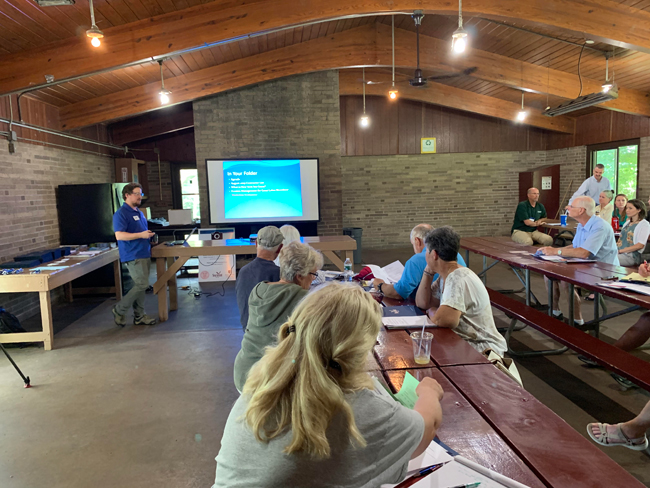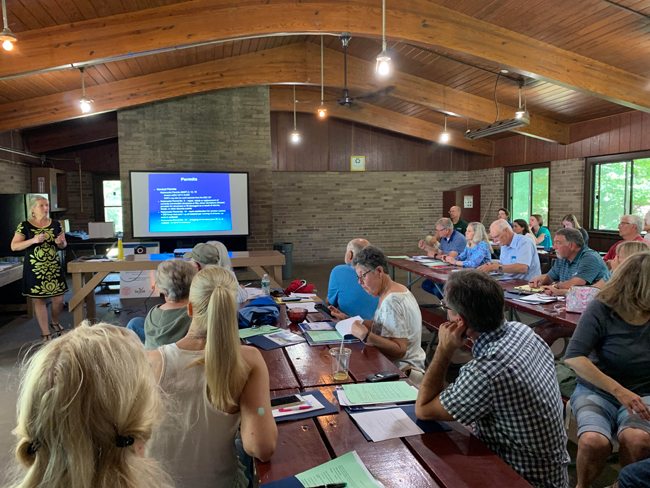
Roy Widrig, New York Sea Grant (NYSG)'s Great Lakes Coastal Processes & Hazards Specialist, was one of four presenters at the workshop. Widrig, author of the Erosion Management for New York’s Great Lakes Shorelines guide (pdf) published by NYSG earlier this year, presented on the role coastal processes have on the design and effectiveness of shoreline erosion management options. Credit: Mary Austerman/NYSG.
Contacts:
Roy Widrig, Great Lakes Coastal Processes and Hazards Specialist, New York Sea Grant, E: rlw294@cornell.edu, P: 315-312-3042
Kara Lynn Dunn, Great Lakes Freelance Publicist, NYSG, E: karalynn@gisco.net, P: 315-465-7578
Oswego, NY, September 5, 2019 - Over 30 shoreline residents gathered on Friday, August 30th at the Parkview Lodge in Webster Park (Webster, NY) for a Shoreline Erosion Management Workshop for Lake Ontario.
Attendees came from Webster, Greece, Hilton and other towns along Lake Ontario to learn more about managing erosion of their shoreline after severe erosion in 2017 and 2019.
Topics presented include Coastal Geologic Processes and Erosion Management Options (Roy Widrig, NY Sea Grant), DEC Permitting (Beth Geldard and Thomas Haley, NYS DEC), DOS Coastal Consistency Review (Laura McLean, NYS DOS) and the US Army Corps of Engineers Regulatory Program (Diane Kozlowski, USACE).
Attendees were given the opportunity for extensive question-and-answer sessions with speakers at the end of the three-hour workshop to discuss management options, working with local zoning professionals, and permitting requirements and options for site consultations with NYS DEC and NY Sea Grant.
Here are the presentations from the event ...
Managing Erosion on Great Lakes Shorelines (PDF)
Roy Widrig, Great Lakes Coastal Processes & Hazards Specialist, New York Sea Grant
Coastal Consistency Review (PDF)
Laura McLean, New York Department of State - Office of Planning and Development
U.S. Army Corps of Engineers Regulatory Program (PDF)
Diane C. Kozlowski, Chief - Buffalo District Regulatory Branch, U.S. Army Corps of Engineers
Lake Ontario Permitting (PDF)
Beth Geldard and Thomas Haley, New York State Department of Environmental Conservation

Diane Kozlowski, from the U.S. Army Corps of Engineers, provided attendees with some examples of activities or structures requiring permits in Lake Ontario. These include docks or decks, boathouses, breakwalls or jettys, seaways, riprap or stone revetments and bioengineered protective structures. Credit: Mary Austerman/NYSG.More Info: New York Sea Grant
More Info: New York Sea Grant
New York Sea Grant (NYSG), a cooperative program of Cornell University
and the State University of New York (SUNY), is one of 33 university-based
programs under the National Oceanic and Atmospheric Administration’s
National Sea Grant College Program.
Since 1971, NYSG has represented a statewide network of integrated
research, education and extension services promoting coastal community
economic vitality, environmental sustainability and citizen awareness
and understanding about the State’s marine and Great Lakes resources.
Through NYSG’s efforts, the combined talents of university scientists
and extension specialists help develop and transfer science-based
information to many coastal user groups—businesses and industries,
federal, state and local government decision-makers and agency managers,
educators, the media and the interested public.
The program maintains Great Lakes offices at Cornell University, SUNY
Buffalo, SUNY Oswego and the Wayne County Cooperative Extension office
in Newark. In the State's marine waters, NYSG has offices at Stony Brook
University in Long Island, Brooklyn College and Cornell Cooperative
Extension in NYC and Kingston in the Hudson Valley.
For updates on Sea Grant activities: www.nyseagrant.org has RSS, Facebook, Twitter, and YouTube links. NYSG offers a free e-list sign up via www.nyseagrant.org/nycoastlines for its flagship publication, NY Coastlines/Currents, which is published quarterly. Our program also produces an occasional e-newsletter,"NOAA Sea Grant's Social Media Review," via its blog, www.nyseagrant.org/blog.